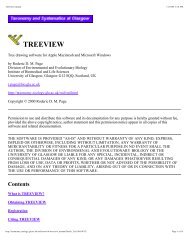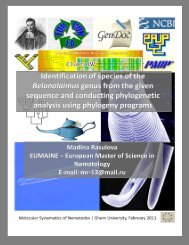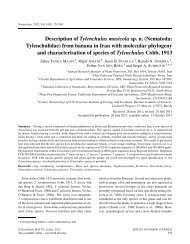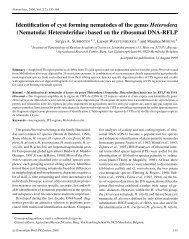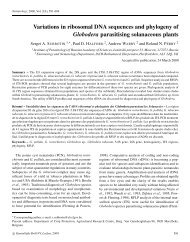Radopholus arabocoffeae sp. n. (Nematoda ... - Donimabe.org.vn
Radopholus arabocoffeae sp. n. (Nematoda ... - Donimabe.org.vn
Radopholus arabocoffeae sp. n. (Nematoda ... - Donimabe.org.vn
Create successful ePaper yourself
Turn your PDF publications into a flip-book with our unique Google optimized e-Paper software.
P.Q. Trinh et al.<br />
Table 5. Reproduction of three <strong>sp</strong>ecies of coffee nematodes on Coffea arabica cv. Catimor seedlings in 250 cm 3 pots under glasshouse<br />
conditions.<br />
Inoculum density Reproduction factor (Rf a )<br />
(nematodes/cm 3 soil) Pratylenchus coffeae <strong>Radopholus</strong> duriophilus R. <strong>arabocoffeae</strong> <strong>sp</strong>. n.<br />
0 0a 0a 0a<br />
1 1.27 a 1.67 a 3.18 b<br />
2 0.64 a 0.94 a 2.46 b<br />
4 0.40 a 0.65 b 2.18 c<br />
8 0.25 a 0.22 a 0.94 b<br />
16 0.09 a 0.12 a 0.59 b<br />
32 0.05 a 0.08 a 0.36 b<br />
a Rf: final nematode number / number of nematodes inoculated. Data are averages of five replicates. Row means followed by the same<br />
letter are not significantly different according to Duncan Multiple Range Test (P 0.05).<br />
(Table 4). Differences in tolerance were observed between<br />
the three <strong>sp</strong>ecies and for three growth parameters. For<br />
P. coffeae, the tolerance limit (T) equalled zero for both<br />
the total weight and root weight; for R. <strong>arabocoffeae</strong><br />
<strong>sp</strong>. n., T was equal to zero for the parameters total<br />
weight and shoot weight. The T-values for R. duriophilus<br />
were low for the total weight (0.8 nematodes/cm 3 soil),<br />
root weight (0.5 nematodes/cm 3 soil) and shoot weight<br />
(0.51 nematodes/cm 3 soil). <strong>Radopholus</strong> <strong>arabocoffeae</strong> <strong>sp</strong>.<br />
n. caused the highest damage to coffee seedlings as<br />
demonstrated by the minimum yield for the parameters<br />
total weight (0.486), root weight (0.297) and shoot weight<br />
(0.289). The order of minimum yield for all of the<br />
parameters ranked: P. coffeae > R. duriophilus > R.<br />
<strong>arabocoffeae</strong> <strong>sp</strong>.n.Clearly,C. arabica cv. Catimor is very<br />
susceptible to all <strong>sp</strong>ecies examined, but e<strong>sp</strong>ecially to R.<br />
<strong>arabocoffeae</strong> <strong>sp</strong>. n.<br />
On C. arabica cv. Catimor both P. coffeae and R. duriophilus<br />
increased in number only at the lowest initial<br />
density (Pi = 1 nematode/cm 3 soil); at higher densities<br />
the reproduction factor dropped below zero and decreased<br />
further with increasing density (Table 5). R. <strong>arabocoffeae</strong><br />
<strong>sp</strong>. n. increased in number up to an inoculum density of<br />
four nematodes per cm 3 of soil; as for the other <strong>sp</strong>ecies increasing<br />
densities caused decreasing multiplication. This<br />
poor multiplication is caused by the detrimental effect of<br />
Pratylenchus and <strong>Radopholus</strong> <strong>sp</strong>ecies on the roots of the<br />
host plant. Species of these genera reduce the root mass,<br />
which eventually rots, rendering plants incapable of supporting<br />
large nematode populations (Loof, 1991). On coffee,<br />
P. coffeae causes lesions on the roots with consequent<br />
destruction of the whole root system (Monteiro &<br />
Lordello, 1974).<br />
Acknowledgements<br />
The senior author gratefully acknowledges the financial<br />
support by a VLIR scholarship for the Master of Science<br />
in Nematology programme at Ghent University, Belgium.<br />
This work was partly supported by the Vietnamese<br />
National Centre for Natural Sciences and Technology.<br />
The authors thank Mrs Rita Van Driessche, Department<br />
of Biology at Ghent University for her assistance in the<br />
SEM preparation and Mr Binh and Mr Hoa, from the Tay<br />
Nguyen Institute of Agriculture and Forests, for their assistance<br />
in sampling.<br />
References<br />
BROOKS, T.L. & PERRY, V.G. (1962). Apparent parthenogenetic<br />
reproduction of the burrowing nematode <strong>Radopholus</strong><br />
similis (Cobb) Thorne. Soil and Crop Science Society of<br />
Florida Proceedings 22, 160-162.<br />
CAMPOS, V.P., SIVAPALAN, P.&GNANAPRAGASAM, N.C.<br />
(1990). Nematode parasites of coffee, cocoa and tea. In: Luc,<br />
M., Sikora, R.A. & Bridge, J. (Eds). Plant parasitic nematodes<br />
in subtropical and tropical agriculture. Wallingford,<br />
UK, CAB International, pp. 387-430.<br />
COBB, N.A. (1893). Nematodes, mostly Australian and Fijian.<br />
Macleay Memorial Volume of the Linnean Society of New<br />
South Wales, pp. 252-308.<br />
COOLEN, W.A.&D’HERDE, C.J. (1972). A method for the<br />
quantitative extraction of nematodes from plant tissue. Gent,<br />
Belgium, State Agricultural Research Centre, 77 pp.<br />
ELBADRI, G.A.A., GERAERT, E. & MOENS, M. (1999a).<br />
Morphological differences among <strong>Radopholus</strong> similis (Cobb,<br />
1893) Thorne, 1949 populations, Russian Journal of Nematology<br />
7, 139-153.<br />
692 Nematology



